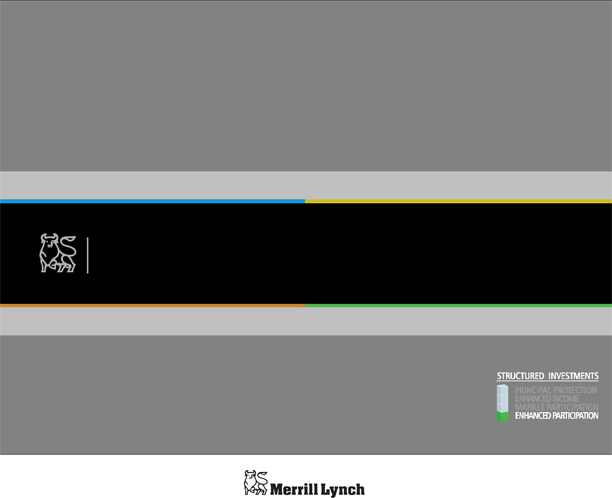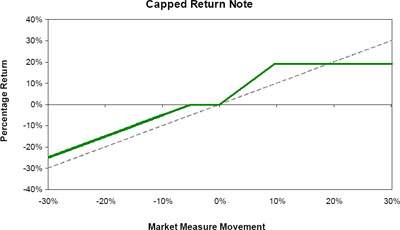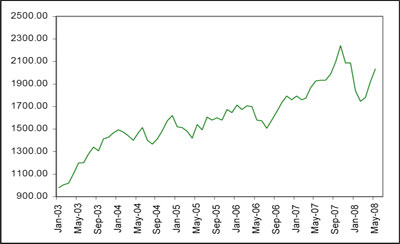Capped Return Notes
Linked to the Nasdaq-100® Index due September , 2009
Certain U.S. Federal Income Taxation Considerations
Set forth below is a summary of certain U.S. federal income tax considerations relating to an investment in the Notes. The following summary is not complete and is qualified in its entirety by the discussions under the sections entitled “United States Federal Income Taxation” in the accompanying product supplement CRN-1 and MTN prospectus supplement, which you should carefully review prior to investing in the Notes.
General. There are no statutory provisions, regulations, published rulings or judicial decisions addressing or involving the characterization and treatment, for United States federal income tax purposes, of the Notes or securities with terms substantially the same as the Notes. Accordingly, the proper United States federal income tax characterization and treatment of the Notes is uncertain. Pursuant to the terms of
the Notes, ML&Co. and every holder of a Note agree (in the absence of an administrative determination, judicial ruling or other authoritative guidance to the contrary) to characterize and treat a Note for all tax purposes as a pre-paid cash-settled forward contract linked to the level of the Index. Due to the absence of authorities that directly address instruments that are similar to the Notes, significant aspects of the United States federal income tax consequences of an
investment in the Notes are not certain, and no assurance can be given that the Internal Revenue Service (the “IRS”) or the courts will agree with the characterization and tax treatment described above. Accordingly, prospective purchasers are urged to consult their own tax advisors regarding the United States federal income tax consequences of an investment in the Notes (including alternative characterizations and tax treatments of the Notes) and with respect to any tax
consequences arising under the laws of any state, local or foreign taxing jurisdiction.
Payment on the Maturity Date. Assuming that the Notes are properly characterized and treated as pre-paid cash-settled forward contracts linked to the level of the Index, upon the receipt of cash on the maturity date of the Notes, a U.S. Holder (as defined in the accompanying product supplement CRN-1) will recognize gain or loss. The amount of such gain or loss will be the extent to which the amount of the cash
received differs from the U.S. Holder’s tax basis in the Note. A U.S. Holder’s tax basis in a Note generally will equal the amount paid by the U.S. Holder to purchase the Note. It is uncertain whether any such gain or loss would be treated as ordinary income or loss or capital gain or loss. Absent a future clarification in current law (by an administrative determination, judicial ruling or otherwise), where required, ML&Co. intends to report any such gain or loss to the
IRS in a manner consistent with the treatment of such gain or loss as capital gain or loss. If such gain or loss is treated as capital gain or loss, then any such gain or loss will be long-term capital gain or loss if the U.S. Holder has held the Note for more than one year as of the maturity date.
Sale or Exchange of the Notes. Assuming that the Notes are properly characterized and treated as pre-paid cash-settled forward contracts linked to the level of the Index, upon a sale or exchange of a Note prior to the maturity date of the Notes, a U.S. Holder will generally recognize capital gain or loss in an amount equal to the difference between the amount realized on such sale or exchange and such U.S.
Holder’s tax basis in the Note so sold or exchanged. Any such capital gain or loss will be long-term capital gain or loss if the U.S. Holder has held the Note for more than one year as of the date of such sale or exchange.
Possible Future Tax Law Changes. On December 7, 2007, the IRS released a notice that could possibly affect the taxation of holders of the Notes. According to the notice, the IRS and the U.S. Department of the Treasury (the “Treasury Department”) are actively considering, among other things, whether the holder of an instrument having terms similar to the Notes should be required to accrue either ordinary
income or capital gain on a current basis, and they are seeking comments on the subject. It is not possible to determine what guidance they will ultimately issue, if any. It is possible, however, that under such guidance, holders of instruments having terms similar to the Notes will ultimately be required to accrue income currently and this could be applied on a retroactive basis. The IRS and the Treasury Department are also considering other relevant issues, including whether
additional gain or loss from such instruments should be treated as ordinary or capital, whether foreign holders of such instruments should be subject to withholding tax on any deemed income accruals, whether the tax treatment of such instruments should vary depending upon whether or not such instruments are traded on a securities exchange, whether such instruments should be treated as indebtedness, whether the tax treatment of such instruments should vary depending upon the nature of
the underlying asset, and whether the special “constructive ownership rules” contained in Section 1260 of the Internal Revenue Code of 1986, as amended might be applied to such instruments. Holders are urged to consult their tax advisors concerning the significance, and the potential impact, if any, of the above considerations to their investment in the Notes. ML&Co. intends to continue to treat the Notes for U.S. federal income tax purposes in accordance with the
treatment described herein unless and until such time as the Treasury Department and IRS determine that some other treatment is more appropriate.
Prospective purchasers of the Notes should consult their own tax advisors concerning the tax consequences, in light of their particular circumstances, under the laws of the United States and any other taxing jurisdiction, of the purchase, ownership and disposition of the Notes. See the discussion under the section entitled “United States Federal Income Taxation” in the accompanying product supplement CRN-1.
TS-8

Capped Return Notes
Linked to the Nasdaq-100® Index due September , 2009
Experts
The consolidated financial statements incorporated by reference in this term sheet from Merrill Lynch & Co., Inc.’s Annual Report on Form 10-K for the year ended December 28, 2007 and the effectiveness of Merrill Lynch & Co., Inc. and subsidiaries’ internal control over financial reporting have been audited by Deloitte & Touche LLP, an independent registered public accounting firm, as stated in their reports, incorporated herein by
reference (which reports (1) expressed an unqualified opinion on the consolidated financial statements and included an explanatory paragraph regarding the changes in accounting methods in 2007 relating to the adoption of Statement of Financial Accounting Standards No. 157, “Fair Value Measurement,” Statement of Financial Accounting Standards No. 159, “The Fair Value Option for Financial Assets and Financial Liabilities—Including an amendment of FASB
Statement No. 115,” and FASB Interpretation No. 48, “Accounting for Uncertainty in Income Taxes, an Interpretation of FASB Statement No. 109,” and in 2006 for share-based payments to conform to Statement of Financial Accounting Standards No. 123 (revised 2004), “Share-Based Payment,” and included an explanatory paragraph relating to the restatement discussed in Note 20 to the consolidated financial statements and (2) expressed an
unqualified opinion on the effectiveness of internal control over financial reporting). Such consolidated financial statements have been so incorporated in reliance upon the reports of such firm given upon their authority as experts in accounting and auditing.
With respect to the unaudited condensed consolidated interim financial information as of March 28, 2008 and for the three-month periods ended March 28, 2008 and March 30, 2007, which is incorporated herein by reference, Deloitte & Touche LLP, an independent registered public accounting firm, have applied limited procedures in accordance with the standards of the Public Company Accounting Oversight Board (United States) for a review of such information.
However, as stated in their report included in Merrill Lynch & Co., Inc.’s Quarterly Report on Form 10-Q for the quarter ended March 28, 2008 and incorporated by reference herein (which report included an explanatory paragraph relating to the restatement discussed in Note 16 to the condensed consolidated interim financial statements), they did not audit and they do not express an opinion on that interim financial information. Accordingly, the degree of reliance on their
reports on such information should be restricted in light of the limited nature of the review procedures applied. Deloitte & Touche LLP are not subject to the liability provisions of Section 11 of the Securities Act of 1933 for their reports on the unaudited interim financial information because those reports are not “reports” or a “part” of the Registration Statement prepared or certified by an accountant within the meaning of Sections 7 and 11 of the
Act.
TS-9

Capped Return Notes
Linked to the Nasdaq-100® Index due September , 2009
Additional Note Terms
You should read this term sheet, together with the documents listed below (collectively, the “Note Prospectus”), which together contain the terms of the Notes and supersede all prior or contemporaneous oral statements as well as any other written materials. You should carefully consider, among other things, the matters set forth under “Risk Factors” in the sections indicated on the cover of this term sheet. The Notes involve risks
not associated with conventional debt securities. We urge you to consult your investment, legal, tax, accounting and other advisers before you invest in the Notes.
You may access the following documents on the SEC Website at www.sec.gov as follows (or if such address has changed, by reviewing our filings for the relevant date on the SEC Website):
|
|
|
|
§
|
Product supplement CRN-1 dated June 3, 2008:
|
|
|
http://www.sec.gov/Archives/edgar/data/65100/000116923208002245/d74383_424b2.htm
|
|
|
|
|
§
|
Index supplement I-1 dated June 6, 2007:
|
|
|
http://www.sec.gov/Archives/edgar/data/65100/000119312507130785/d424b2.htm
|
|
|
|
|
§
|
MTN prospectus supplement dated March 31, 2006:
|
|
|
http://www.sec.gov/Archives/edgar/data/65100/000119312506070946/d424b5.htm
|
|
|
|
|
§
|
General prospectus supplement dated March 31, 2006:
|
|
|
http://www.sec.gov/Archives/edgar/data/65100/000119312506070973/d424b5.htm
|
|
|
|
|
§
|
Prospectus dated March 31, 2006:
|
|
|
http://www.sec.gov/Archives/edgar/data/65100/000119312506070817/ds3asr.htm
|
Our Central Index Key, or CIK, on the SEC Website is 65100. References in this term sheet to “ML&Co.”, “we”, “us” and “our” are to Merrill Lynch & Co., Inc., and references to “MLPF&S” are to Merrill Lynch, Pierce, Fenner & Smith Incorporated.
ML&Co. has filed a registration statement (including a prospectus) with the Securities and Exchange Commission (the “SEC”) for the offering to which this term sheet relates. Before you invest, you should read the prospectus in that registration statement, and the other documents relating to this offering that ML&Co. has filed with the SEC for more complete information about ML&Co. and this offering. You may get
these documents without cost by visiting EDGAR on the SEC Website at www.sec.gov. Alternatively, ML&Co., any agent or any dealer participating in this offering, will arrange to send you the Note Prospectus if you so request by calling toll-free 1-866-500-5408.
Structured Investments Classification
ML&Co. classifies certain of its structured investments (the “Structured Investments”), including the Notes, into four categories, each with different investment characteristics. The description below is intended to briefly describe the four categories of Structured Investments offered: Principal Protection, Enhanced Income, Market Participation and Enhanced Participation. A Structured Investment may, however, combine
characteristics that are relevant to one or more of the other categories. As such, a category should not be relied upon as a description of any particular Structured Investment.
Principal Protection: Principal Protected Structured Investments offer full or partial principal protection at maturity, while offering market exposure and the opportunity for a better return than may be available from comparable fixed income securities. Principal protection may not be achieved if the investment is sold prior to maturity.
Enhanced Income: Structured Investments offering enhanced income may offer an enhanced income stream through interim fixed or variable coupon payments. However, in exchange for receiving current income, investors may forfeit upside potential on the underlying asset. These investments generally do not include the principal protection feature.
Market Participation: Market Participation Structured Investments can offer investors exposure to specific market sectors, asset classes and/or strategies that may not be readily available through traditional investment alternatives. Returns obtained from these investments are tied to the performance of the underlying asset. As such, subject to certain fees, the returns will generally reflect any increases
or decreases in the value of such assets. These investments are not structured to include the principal protection feature.
Enhanced Participation: Enhanced Participation Structured Investments may offer investors the potential to receive better than market returns on the performance of the underlying asset. Some structures may offer leverage in exchange for a capped or limited upside potential and also in exchange for downside risk. These investments are not structured to include the principal protection
feature.
The classification of Structured Investments is meant solely for informational purposes and is not intended to fully describe any particular Structured Investment nor guarantee any particular performance.
TS-10








